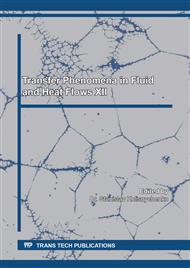p.33
p.51
p.67
p.83
p.99
p.109
p.119
p.129
p.141
Numerical Investigation of the Interaction between the Thermal and Dynamic Effects of Cross-Ventilation for a Generic Isolated Building
Abstract:
An efficient air ventilation requires knowledge of the complex interaction between the dynamic behavior and thermal parameters. For an isolated building the exact estimation of the interaction between the dynamics of cross-ventilation flow and a convective heat transfer, by overheating one of its internal walls, is an interest way to control the internal temperature’s distribution and the energy consumption of the ventilation system. The numerical simulation may provide an approximate solution to predict this kind of phenomenon. In this study, a numerical investigation of the thermal effect of a heated wall on a cross-ventilation for a generic isolated building with two parallel openings with a same dimension and at the same height is presented. The heat source is considered as solar radiation when it heats the exposed wall of the building. The wall temperature is assumed to be constant and homogeneous and it takes three values 25, 30 and 35°C. The highly three-dimensional flow is obtained by solving numerically the Reynolds averaged equations of mass, momentum and energy conservation for incompressible flow. The k-ω SST turbulent model is used to solve the turbulent quantities. The numerical results are validated by comparison of the horizontal component of velocity and the turbulent kinetic energy with the corresponding measurements. A detailed analysis of the interaction between the dynamic and thermal parameters is carried out and led to conclude that the distribution of the air temperature in the building is much influenced by the incoming fresh air jet. In its region the temperature difference between the air inside and outside the building is almost zero, however, below the jet region, characterized by air recirculation flow, the temperature takes its maximum value for the tree studies cases. Also, the thermal effects of air buoyancy may modify the dynamic behavior, especially at the building entrance, this modification is proportional to the wall temperature and it disappear after mid distance of the flow in the building.
Info:
Periodical:
Pages:
141-153
Citation:
Online since:
April 2021
Authors:
Price:
Сopyright:
© 2021 Trans Tech Publications Ltd. All Rights Reserved
Share:
Citation:


